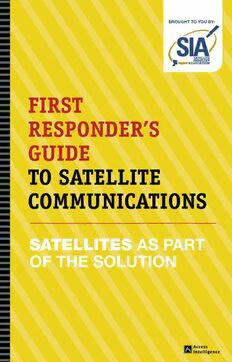
First Responders Guide to Satellite Communications PDF
24 Pages·2018·6.596 MB·English
Most books are stored in the elastic cloud where traffic is expensive. For this reason, we have a limit on daily download.
Preview First Responders Guide to Satellite Communications
Description:
Following the 2005 hurricane season, the Asian Tsunami, the earthquake in Pakistan, and the 9/11 terrorist attacks, satellite communications immediately stepped in to fill the communications and command and control gap created by the devastation of the terrestrial network. The lack of operable, terrestrial communications infrastructure resulting from these disasters severely impeded command and control functions, situational awareness, and therefore, the disaster relief and recovery efforts of first responders.When the telephone and broadcast networks went down, satellites remained on the job. Satellites connected emergency personnel and other first responders. Satellites reunited families. Satellites reconnected communities. Satellites enabled the world to witness the devastation of these disasters and also the many acts of heroism.In many of the affected areas, satellites provided the only source of communications in the hours, days, and weeks following these events. Satellites provided the basic ‘operability’ that terrestrial networks could not provide following those disasters.The Satellite Industry Association (SIA) and its member companies hope that the First Responder’s Guide to Satellite Communications provides users in public safety, homeland security, and emergency preparedness with the basic fundamental information needed to effectively incorporate satellite communications into the preparations for the next natural or man-made disaster.
See more
The list of books you might like
Most books are stored in the elastic cloud where traffic is expensive. For this reason, we have a limit on daily download.
